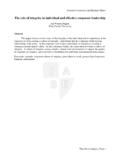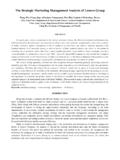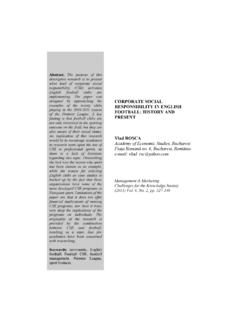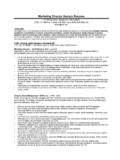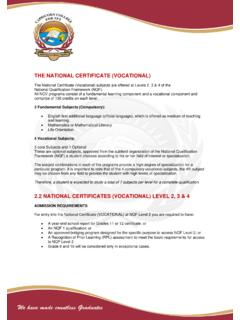Transcription of How Religion has Embraced Marketing and the …
1 Journal of management and Marketing Research, Volume 2. How Religion has Embraced Marketing and the Implications for Business Ann Kuzma Minnesota State University, Mankato Andrew Kuzma Yale University John Kuzma Minnesota State University, Mankato ABSTRACT. Religion , in many respects, is a growth industry. One particularly successful manifestation of this growth is the megachurch, defined as a Protestant church with at least 2,000 weekly attendants. On the other hand, many mainstream Protestant churches have experienced membership declines. The purpose of this paper is to explore the success of the megachurch from a Marketing strategy perspective. The implications that this might have on the discipline of Marketing and business in general will be discussed.
2 Directions for future research are identified. How Religion Has Embraced , Page 1. Journal of management and Marketing Research, Volume 2. INTRODUCTION. On August 16, 2008, Pastor Rick Warren of the Saddleback Church in Lake Forest, California hosted presidential candidates John McCain and Barrack Obama in a nationally televised question and answer session. The Saddleback Civil Forum on Presidency was the first time both candidates had appeared on stage since becoming the presumptive nominees for their respective parties. The location of this event, Saddleback Church, is typically referred to as a megachurch (Murray & Bacon, 2008). The Hartford Institute for Religion Research describes megachurches as very large, Protestant congregations that generally have 2,000 or more persons in attendance in weekly worship.
3 The term megachurch, in addition to describing the size of attendance, is also used to describe the nature of the religious faith. Megachurches are also likely to have a charismatic, authoritative senior minister and have a conservative theology ( Megachurch Definition, 2006). In management 's New Paradigms, Peter Drucker (1998) described megachurches as the most important social phenomenon in American society in the last thirty years. A 2005 report sponsored by the Hartford Institute for Religion Research estimated that, nationwide, there were over 1,210 of these megachurches, nearly double the number that existed in 2000 (Thumma, Travis & Bird, 2005). Thirty-five of the top 100 megachurches draw 10,000-plus people each week, prompting the creation of a new term: gigachurches.
4 The rest of the 100 have a weekly attendance of 6,000-plus (Kwon, 2007). One of the key growth trends in this area is multi-site technology. Seven of the top ten fastest-growing churches are multi-site churches in which churches set up extension sites, or branches across the city, state, or country (Kwon, 2007). Some of the multi-sites are intended to be more intimate, perhaps only offering services to groups of 200 people. Others attempt to reach different cultural or generational segments (Hinkle, 2006). Within the megachurch complexes, members can browse in bookstores, or libraries, visit with other members in coffee shops, attend support or self- help groups, and participate in fitness classes.
5 Prestonwood Baptist Church in Plano, Texas is spread over a 140-acre campus that includes eight playing fields and six gyms (Symonds, Grow & Cady, 2005). The growth of the megachurch can be attributed to many factors, not the least of which is the sophisticated Marketing that these churches have Embraced . Marketing research, segmentation, positioning, branding, product development, integrated Marketing communications and distribution strategy are clearly understood and utilized in the Marketing strategies of successful megachurches. In fact, some critics have dismissed the so-called slick Marketing of megachurches as evidence of how such churches are somehow not religious enough (Axtman, 2003; Baird, 2006; Hinkle, 2006.)
6 Goodman, 2008). The purpose of this paper is to examine the phenomenon of the megachurch in terms of basic Marketing strategy, specifically the customer-driven orientation that successful businesses have adopted. First, a brief overview of the use of Marketing by religions and churches is presented as well as a snapshot of the current state of religious affiliations in the United States. The target Marketing and Marketing mix of Wal-Mart is used to describe the success of the megachurch. In addition, the How Religion Has Embraced , Page 2. Journal of management and Marketing Research, Volume 2. ramifications for the competitive environment of the megachurch and the impact on business in general are discussed.
7 Finally, the use of a faith-based Marketing strategy is briefly examined. THE Marketing OF Religion . In the classic 1969 article, Broadening the Concept of Marketing , Philip Kotler and Sidney Levy considered the applicability of Marketing concepts to the problem of promoting social causes. Included in their identification of social causes were the efforts being used to increase church membership, which they clearly felt constituted basic Marketing principles. Since then, a number of articles and books have examined the use of Marketing strategies by churches and attempted to evaluate the effectiveness of such strategies (Twitchell, 2005; Bass, 2007). Rothschild (1979) and McDaniel (1986), however, both identified problems associated with the so-called selling of Religion .
8 Specifically, mainstream clergy, although well-schooled in the dogma of faith, were not necessarily skilled in the practice of Marketing . In addition, the clergy and the public they hoped to attract sometimes found the use of Marketing techniques to be inappropriate or gimmicky. Somewhat ironically, McDaniel (1986) found that the general public considered many forms of church advertising to be inappropriate, while clergy tended to have more favorable views. Two decades later, the use of church Marketing has expanded throughout mainstream denominations and been adopted by many non-denominational groups. In fact, it would probably be difficult to find any church that has not at least explored the possibilities of using Marketing .
9 McDaniel's 1986 study evaluated communication techniques such as billboards, direct mail, handbills, newspapers, on-premise signs, bumper stickers, radio and television, and the yellow pages. Today's Marketing communication methods would also include e-mail, websites, internet banner ads, and sponsorship of sports and other events. Although many mainstream churches have become more willing to use a Marketing orientation, they continue to lose membership. The Pew Forum on Religion and Public Life, a project of the Pew Research Center, recently reported on the religious affiliation of the American public and the various shifts taking place in the religious environment ( Religious Landscape, 2008).
10 Notable among their findings was that more than one-quarter of American adults (28%) have left the faith in which they were raised in favor of another Religion or no Religion at all ( Religious Landscape, . 2008). If change in affiliation from one type of Protestantism to another is included in the analysis, about 44% of adults have either switched religious affiliation, moved from being unaffiliated with any Religion to being affiliated with a particular faith, or dropped any connection to a specific religious tradition altogether ( Religious Landscape, . 2008). The large denominations, such as the United Methodist Church and the Episcopal Church have lost more than 1 million members in the past 10 years (Symonds, Grow & Cady, 2005).









